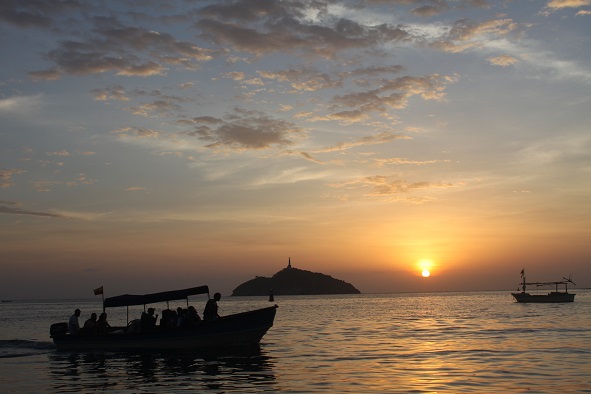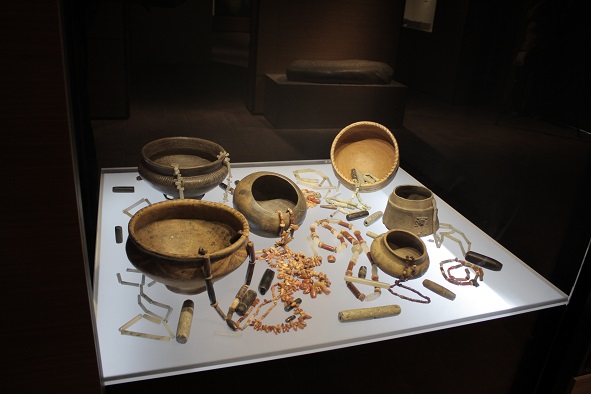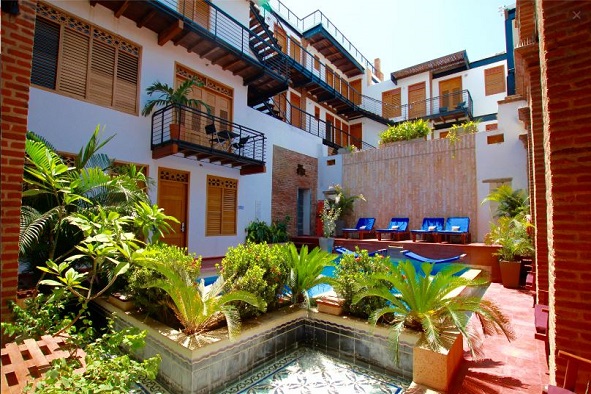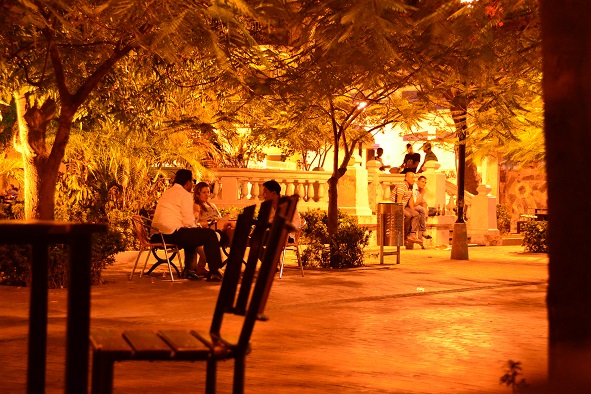Caribbean flair, tropical rhythms and a burgeoning culinary scene to tantalize the senses, Santa Marta has become Colombia’s must-visit destination. While the nearby cream cashmere beaches and verdant jungle of Tayrona National Park take the headlines, charming Santa Marta provides a perfect introduction to Caribbean Colombia.

Sunset in Santa Marta (Photo: Eli Duke via Flickr)
Santa Marta, located on Colombia’s northern, Caribbean coast, not only has deep roots in South America’s history, but parts of its old town are as beautiful as its well-known neighbor Cartagena.
Saunter through lively side streets, underneath flower-draped balconies and enjoy a Caribbean culture dating back to the 16th century. Aromas from sizzling, locally-caught fish fill the air, along with the rhythms of guitarists and bongo players lining the alleyways beneath twinkling street lights.
For pure enchantment head to Parque de los Novios (Park of the Sweethearts). From sunset to late at night this gorgeous spot welcomes romancers either snuggling up on benches or dining at one of the fine al fresco restaurants.
Santa Marta is the oldest surviving colonial city in Colombia and offers an insight into life before, during, and after the Spanish conquest. The white-washed Tayrona Gold Museum, located on Bolivar Park, is the city’s oldest house and was built by Spanish settlers in 1531. Several rooms here display stunning pre-Columbian artifacts, like fine gold jewelry, and trace the fascinating lives of indigenous communities that remain to this day. Exhibitions and videos detail the emergence of four main indigenous groups descending from the Tayrona people of the 7th century.

Tayrona Gold Museum (Photo: Enrique Restrepo via Flickr)
A visit to Tayrona Gold Museum is a great prelude to a Sierra Nevada de Santa Marta trip, where people from these communities – Wiwa, Arhuaco, Kogi and Kankuamo – still live. This spectacular house, known as the Casa de la Aduana, is a must-visit. Entry is free.
Afterward, relax in the beautiful square in the shadow of the great liberator himself, Simón Bolívar. Walks along the sea front, sampling tropical fruit juices, devouring street food like arepa (cornbread), arroz con coco (coconut rice) or fried plantain, are also popular. Alternatively, throw off your sandals and dip your toes into the warm, tranquil waters of the Caribbean.
Hotels
Nowhere in Santa Marta merges luxury and a laid-back vibe like Casa Carolina (Calle 12 #3-40). This stunning boutique hotel, located in the city’s historical center, boasts a seductively lit pool surrounded by swinging chairs, gently whirring fans and cushioned loungers. The balconies and verdant greenery complete the outside-inside feel while the rooftop jacuzzi allows for late-night bubbling and panoramic views of the historical center. Dotted inside this beautifully restored 18th-century townhouse are pockets of solitude like private jacuzzis, sun terraces, and a space for a romantic meal with a private butler. Casa Carolina also offers boat trips to seldom-visited, and not-easily-accessed, beaches in the simply stunning Tayrona Park.

Casa Carolina (Photo: Casa Carolina)
Hotel Tayromar (Calle 20 #1c-71) tops the list of comfortable and affordable hotels with ocean views. With rooms ranging from doubles to dorms, this charming hotel caters for all types. And while the friendly and knowledgeable staff is a welcome addition, it’s the rooftop breakfast that delights guests – crispy homemade arepas with eggs or platters of mango, guava and pineapple and, of course, unlimited coffee. Of the lesser-known spots, Casa del Escritor (Carrera 7 # 14-11) is a real find. Passages from iconic novels decorate most walls while books cover most tables. You even sense the literary vibe emanating from its ultra-friendly owner, himself a writer. Rooms are individually designed and the cooked breakfast comes with perfectly-brewed coffee or a selection of teas. Alternatively, Hotel Miramar (Calle 10C #1C-59) hosts those yearning for the hotel/hostel experience. The welcoming and brightly colored communal area is often brimming with travelers and is a great place to meet people. Located a block from the beach, this hotel is an inexpensive choice with basic but comfortable rooms and air conditioning.
Eat & Drink
A sojourn to Santa Marta wouldn’t be complete without a visit to the iconic La Puerta (Calle 3 # 16 28). This bouncing bar/club rocks out salsa and modern-day classics to a mix of locals and foreigners most nights. Several small rooms, each decorated with images of authors, artists and film stars, teem with revelers, especially on weekends. The back patio offers respite from the sweaty middle dancefloor that is often cooled from the rain, which pours in through the mesh roof. The drinks selection includes a list of French wines and cocktails.
Casa Carolina’s in-house restaurant, Eli’s (Calle 12 #3-40), serves up a varied menu of gourmet dishes catering to candle-lit diners. Those bathing in the pool during the day can opt for a club sandwich or burger after a swim. With a real eye for detail, the chefs source local – often organic – ingredients, to create dishes such as filet mignon in red currant and wine, or a mixed prawn and sea bass ceviche with orange zest, sesame oil, and red onion.
Duck under the low-hanging trees in the simply stunning Parque de Los Novios to find one of the city’s finest restaurants. Ouzo (Carrera 3 #19-29) merges Greek and Italian cuisine with friendly service and an outlandish cocktail list. Few places can match the stone oven-baked pizzas, freshly made pasta or the pan-seared octopus with feta cheese. Head chef, Michael McMurdo, who trained in New York, lays claim to having elevated the cuisine in Santa Marta to a high level and he’s constantly crafting classic Mediterranean dishes with modern twists. Top tip: if you fancy a romantic meal, reserve a table on the open-air patio.

Parque de Los Novios (Photo: Robert Schrader via Flickr)
From the first glance, it’s clear that La Canoa Café Cultural (Calle 18 #3-75) offers something special. Its white-washed walls, towering arches and black and white tiled floor would not look out of place among the chic pavement cafés in Paris. In fact it’s this French influence, fused with the Caribbean, that makes this spot so popular. As well as fine pastries like éclairs or pain au chocolates and the French baguettes baked on site, the coffees are superb. From the traditional tinto (black coffee) to lattes infused with amaretto or baileys, friendly staff make sure your caffeine fix comes with a touch of class. Some evenings, live music also entertains guests as well as cinema nights and photography exhibitions.
Few places serve up a healthy and wholesome breakfast like Lulo (Carrera 3 #16-34). This diminutive spot, offers a chalk board full of freshly-made sandwiches and an array of liquid refreshments. Those looking to recharge their batteries after a night of dancing can opt for a cup of Joe or one of the reinvigorating fruit juices. Alongside the traditional flavors like passion fruit, mango, and grape are a few stand-outs like rum, mango, and basil.
Head down one of the side streets off Parque de Los Novios to find a café that holds more than meets the eye. Ikaro’s (Calle 19 #360) menu not only includes a delicious array of vegetarian food, this tranquil spot serves up the finest 100 percent organic coffee in the city. Using beans cultivated at a farm in the Sierra Nevada de Santa Marta, Ikaro has shown a real dedication to protecting the region’s national park. They also guarantee that for every bag of coffee bought they plant a tree in the Sierra, helping the much-needed reforestation program.
Shopping
With a rich blend of cultures, some dating back to the 7th century, and a modern colorful Afro-Caribbean influence, Santa Marta serves up a plethora of diverse shopping options. One of the most iconic fashion items is the beautifully made indigenous bags, which are sold around the historical center. Outside the Tayrona Gold Museum, rows of hand-woven bags line the street with their bright red, yellow and orange patterns signifying origins with the Wayuu. These indigenous women inhabit La Guajira – a desert region to the east of Santa Marta – and each of their bags are said to be completely unique.
Another sacred line of bags from the Arhuaco women of the Sierra Nevada de Santa Marta can be bought from street vendors around Parque de Los Novios. However, to guarantee true authenticity, the best place to head is Casa Indigena (Carrera 19 a #23-37). Despite being slightly out of town, it’s worth the trip as the bags come directly from the Arhuaco community, meaning profits go directly to them. Make sure to ask about the intricate patterns and colors on the bags as they have sacred meanings and fascinating stories.
Many local fashion retailers are merging the traditions of the indigenous cultures with the colorful flair of the Caribbean, and one of the newest brands is Bananalife (Calle 16 # 3 – 28). This store, located off a side street from Parque de Los Novios, sells a seemingly random assortment of items, from vibrantly colored bikinis and skirts to retro grammar phones, intricate lampshades and dolls. Every detail catches the eye like the open courtyard at the back and the luminous washrooms with bamboo shutters and gold-framed mirrors.
The side streets leading from Plaza la Catedral teem with vendors selling items like books, artisanal jewelry, organic coffee and sombreros. The tight streets often get crowded at the weekends with visitors testing their bargaining skills with the locals. If the sun gets too much, head inside the artisanal market opposite Hotel Tayromar (Calle 20 #1c-71). Here, a host of sellers have covered tables with fine handicrafts, artisanal wine, bags and bangles. Once again, bargaining is the name of the game so be prepared to readily use phrases like: Cuanto es lo minimo que me lo deja? (How low can you go for me?).